|
The term applies to all vessels clad with iron for defense. The introduction of iron armor for the protection of ships is of very recent date. Formerly, as we find by allusions in history, there had been instances where efforts were made to protect the sides of ships by timber or hides, but these seem to have been isolated cases due to the ideas of some individual commander. With the artillery that was in use in the 15th, 16th, and 17th centuries there was no call for any aid in the defense of ships, and the term “wooden walls” conveyed the idea of an all-sufficient protection; and the correctness of the idea is sufficiently apparent when we refer to the actions of such commanders as Blake and Van Tromp being continued day after day, and being finally closed without definite result. In the 18th century artillery had become much more formidable, but it was not until early in the 19th century that any definite shape was given to the idea of protecting the sides of a ship from the fire of an enemy; and even when it was first seriously proposed it met with great disfavor, and has had to fight its way against determined opposition and prejudice. Thomas Gregg, of Pennsylvania, is given the credit of the first definite proposition for an ironclad vessel in 1813, but no decided step in developing the subject was taken until Mr. Stevens, of New York, made his contract with the U. S. government in 1843 for the construction of an armed vessel. The date of this, the first decided step in the direction of armor for ships made by any government, is worthy of note, for we find that it was at about the same period of time that horizontal firing of explosive projectiles from the batteries of ships of war became general. The connection between the two circumstances is apparent, and there can be no doubt that the introduction of the shell as a projectile has caused the use of iron for armor. The development of armor ceased at this time with the above contract for the Stevens battery, and it was not until after the Crimean war (1855) that efforts were renewed to introduce armor.
The different types of ironclads are so numerous that it is impossible to enumerate them in a paper of this character; they can be generally ranged under two heads, namely, as broadside and turreted vessels. The first efforts were naturally confined to the construction of broadside ironclads; the turreted vessels were of later date of construction, due to an invention of Mr. Ericsson, of which mention will be made later. The broadside ironclads will be first presented, and the rate of development during the past twenty years can be estimated by citing a few instances in the course of the application of the system. The work of developing the system was assumed by England and France alone, and after a certain point had been reached England was left alone to continue the work, carrying it to its present state. The conclusions that have been readied by her investigations and experiments have been adopted and applied by other nations, but the English ironclads are the proper citations to make in tracing the advancement of the system.
The following table presents the first experiments made in the development of sea-going broadside ironclads: 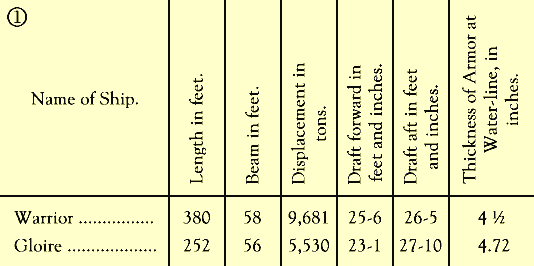
|
After the construction of these vessels the mode of procedure of the two governments was very unlike, the French plan being to build a large number of similar vessels, while the English plan is apparent in numerous vessels of dissimilar construction. Two examples are cited of a type that has been repeated very often in the French service, thus forming the chief part of her ironclad fleet. 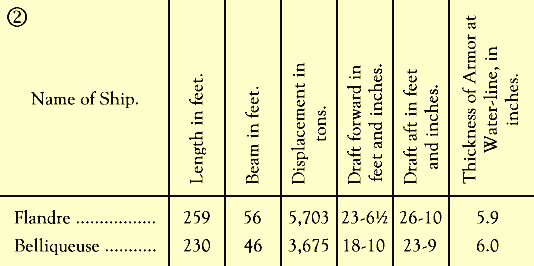
| The class of the Flandre type is armed with eight 12-ton guns and four 7-ton guns. The class of the Belliqueuse type is armed with six 7-ton guns. The following examples (taken, as are the above, from King's Report on European Ships of War) illustrate the progress made in England in the development of ironclads of the broadside type: 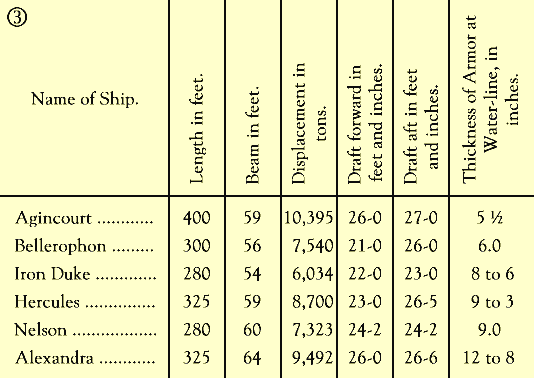
| Since the time of the completion of the Warrior there has
taken place a great change in the way of disposing the armor, and this has
been influenced by the change in the artillery, which concentrates a
greater power now in a few guns than was developed in the
Warrior's armament by a larger number of guns. The
It has always been very desirable to give the guns as much lateral
train as possible, but when the guns, few in number, were
concentrated in the central part of the vessel, it became the more
necessary to increase this property in them. From the effort to
achieve this object have arisen many of the modifications in the
development of the fleet of ironclads, which account for the
The introduction of turreted ironclads is due to a call for ironclads made by the U. S. government during the war of the Rebellion of 1861. Among those who responded to this call was Mr. John Ericsson, of New York, who submitted the plans of the Monitor. Agreeably to the conditions named by the Navy Department, the following problem was presented to him : an ironclad vessel of small dimensions capable of navigating the Southern rivers, and absolutely impregnable against the ordnance possessed by the Southern States. The draft of water being thus limited to about 11 feet, impregnability could only be insured by nearly immersing the hull, as high freeboard and impregnability would have called for an amount of weight incompatible with light draft and small tonnage. Absolute protection to guns and guns' crews being also an imperative condition, called for the adoption of a covered battery, which was made cylindrical, and, in order to obviate the necessity of maneuvering the vessel in narrow rivers, the battery or turret was made to revolve around a vertical axis, in order to insure an all-around fire while the vessel remained stationary. As the light draft of this small ironclad brought the top of the propeller very near the water-line, a projecting deck, or stern overhang, was adopted for the protection of the propeller blades. The principal object of the Monitor being that of
engaging shore-batteries at short ranges, facilities for dropping and
lifting the anchor without exposing the crew also presented a problem
for solution, hence the adoption of the overhang deck at the bow,
provided with a cylindrical well in which the anchor was suspended
after being lifted by mechanism arranged within the hull. In order to
give thorough protection, the steam machinery, as well as the
quarters for officers and men, were located below the water-line, and
further protected by a continuous side-overhang. This consisted of
the armor and wood backing, first styled “armor timber,” which was
bolted to the iron hull, being supported by a horizontal girder
running all along the side, called an “armor shelf,” which was
assisted by vertical gussets of iron secured at intervals to the side
by angle-irons. The wood backing was disposed in two layers between
these gussets, and the armor, consisting of five 1-inch plates, was
bolted on outside of all. The armor shelf, disposed as a horizontal
girder, formed the base of this projection from the side, and
presented a very formidable resistance to any inclination or tendency
The principle of the Ericsson turret, with modifications in the
plan of revolving it, has been adopted by other nations, notably by
England, and is perpetuated in her large fleet of turreted vessels, but
decided departure is taken in their construction from the original design
By common, tacit consent of nations, turreted vessels are not supplied with masts and sails. The experiment was tried in England, where were built the Monarch and the Captain; both of these vessels had comparatively high freeboards, that of the Monarch being 8 feet in height. The Monarch has not been duplicated, and the Captain capsized under sail and foundered during her first experimental cruise. The effort in these vessels was to raise the turret-ports higher above the water; this was done by raising all the weights and building up the armored sides to the required height. The effect of this plan was demonstrated in the melancholy catastrophe that befell the Captain. The same result, so far as raising the ports higher is concerned, is achieved now by the English Admiralty in their turreted vessels of later date by building, on a deck of low freeboard, a breastwork which protects the lower portions of the turrets and smoke-stacks, and affords a shelter to the hatchways from water that may come on deck. The breastwork-turreted vessels carry two turrets, and the space inclosed by the breastworks occupies a large portion of the length of the vessel, consequent this is provides a large surface to resist the wash of seas that find their way over the rail on to the deck, and thus a rolling motion is induced which does not obtain in the Ericsson monitor. The rail itself of the breastwork-turreted vessels is much higher than in the monitor as designed, and every inch of height of freeboard increases this tendency to roll to a great degree. There is one point about the breastwork-turreted vessel which is referred to as a great advantage, but which is more imaginary than real; it is that the breastwork affords a protection to the hatchways, which can he left open when the seas are flowing across the deck, and thus allows natural ventilation to the ship. Carefully-prepared statistics, gathered from the experience of the Ericsson monitors during the war of the Rebellion, show that the health of the crews of the monitors was better than that of the crews of the rest of the blockading squadrons. The artificial ventilation of the monitors, effected by centrifugal suction-blowers operated by steam, is thus proved to be all-sufficient. In comparing the original design of the Monitor with the turreted vessels of other nations, we find that for harbor defense the monitor is the more steady gunnery platform, but for service at sea the breastwork-turreted vessel is the more efficient. Besides England, the only nations in Europe that have adopted the turret system to any extent are Holland and Italy. The Russian navy is provided with a few monitors of the Passaic class. The following tables, present examples of turreted vessels in the navies of the three nations who have adopted the system in whole or in part. The fighting force of the Dutch navy is composed entirely of turreted vessels. They are designed for harbor defense, and are considered of sufficient power to cope with such vessels of an enemy as have light draft sufficient to enable them to approach a shallow coast. 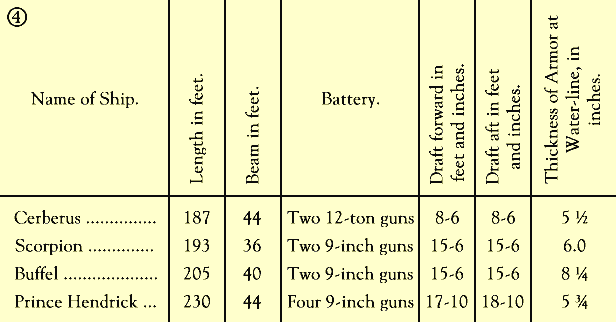
| The following are examples taken from the list of English turreted vessels: 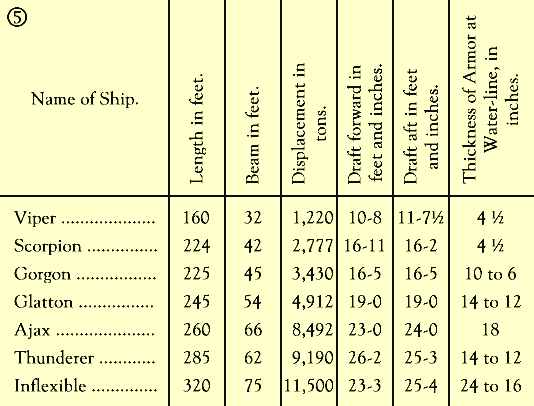
| The broadside ironclads of Italy are armored with iron of from 4.5 to 6 inches, but in the development of the turret system they have taken a step in advance of the rest of the world, The following table cites the latest efforts of Italy in this respect: 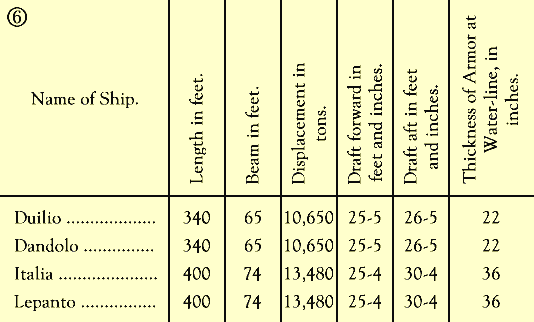
| These vessels are armed with four 100-ton Armstrong guns. The central portion of these vessels is plated with steel instead of iron, in consequence of the result of experiments made with the 100-ton gun against targets constructed on different systems of steel and iron. In reference to the weight of the guns that can be carried by vessels of the broadside and turreted systems, respectively, it is shown that it has not been attempted to work a heavier piece than a 2-ton gun in a broadside battery, while we see that the armament of the Duilio (turreted vessel) consists of 100-ton guns. So far, then, as capacity to manipulate the heavier gun is concerned, the turreted vessel has the advantage over broadside ironclads. The necessity of providing ironclad vessels with capacity to float the increased weight due to their armor has forced great changes in naval architecture. The V-shaped cross-section of the Warrior has given place to one of a U form, and a comparison of the dimensions of the lightly armored Warrior with the heavily-armored Alexandra show the modifications that have been introduced in this respect. The graceful overhanging bows have been suppressed, and the sterns are designed so as to afford protection to the screw and rudder. So great is the thickness of plates that have now been called into use in consequence of the development of power in guns, that efforts are being made to utilize other metals than iron in hope of reducing the weight of the armor while retaining power of resistance to impact. It has been mentioned above that steel is being used for the plates of the Italian turreted vessels, and it has also been discovered that an iron plate faced with steel, by welding when the steel is in a liquid state, increases the power of resistance to a great degree. It is probable that the latter plan will be very generally adopted for the armor of ironclads. |
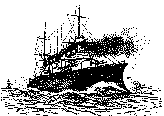 Back to John's Nautical Page
Back to John's Nautical Page
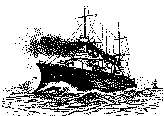
|
| Send comments to John Kohnen, jkohnen@boat-links.com |
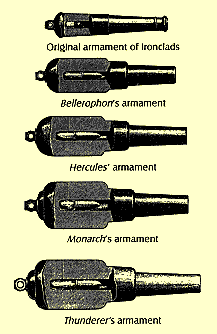 During the Crimean war a few ironclad batteries had been
constructed by the French, and it was the behavior of these vessels in
their ability to resist the effect of shells which induced the English and
French governments to commence the construction of ironclad ships. In 1858
the work of conversion and construction was commenced in earnest, and it
has been carried on unremittingly to the present day. As the capacity for
defense increased, the power of offense was added to by increasing the
power of the guns, and thus have arisen the wonderful fleets of ironclads
that we now see on the ocean.
During the Crimean war a few ironclad batteries had been
constructed by the French, and it was the behavior of these vessels in
their ability to resist the effect of shells which induced the English and
French governments to commence the construction of ironclad ships. In 1858
the work of conversion and construction was commenced in earnest, and it
has been carried on unremittingly to the present day. As the capacity for
defense increased, the power of offense was added to by increasing the
power of the guns, and thus have arisen the wonderful fleets of ironclads
that we now see on the ocean.
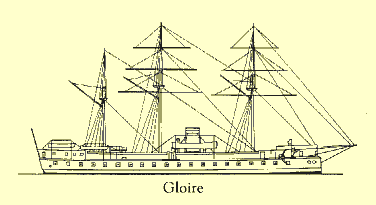 In 1858 the French built La Gloire, and the English
built the Warrior. The Gloire was a wooden
hull, but the Warrior was iron built. This error in the
French construction was continued for many years, and had the effect
of throwing her back in the struggle for supremacy, as the deterioration of
the wood covered by iron plating made repairs frequent, and increased
expense.
In 1858 the French built La Gloire, and the English
built the Warrior. The Gloire was a wooden
hull, but the Warrior was iron built. This error in the
French construction was continued for many years, and had the effect
of throwing her back in the struggle for supremacy, as the deterioration of
the wood covered by iron plating made repairs frequent, and increased
expense.
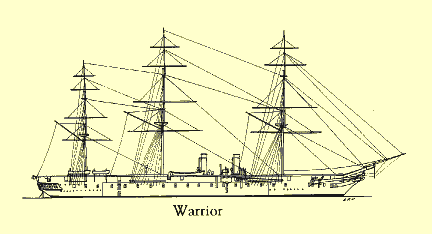 The Gloire carried a battery of thirty-six 6-inch guns,
but the Warrior carried a battery of ten 12-ton (9-inch) and
sixteen 6.5-ton (7-inch) guns, which made her much the more formidable
vessel.
The Gloire carried a battery of thirty-six 6-inch guns,
but the Warrior carried a battery of ten 12-ton (9-inch) and
sixteen 6.5-ton (7-inch) guns, which made her much the more formidable
vessel.
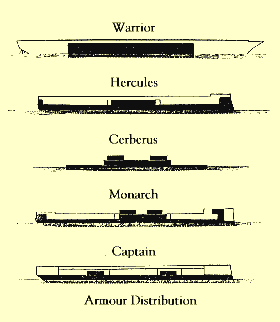 Warrior was armored amidships only, that is, abreast of her
battery; the ends were unprotected. In later constructions a continuous belt
of armor is considered indispensable all around at the water-line, and
the side-armor is carried up around the more contracted space devoted
to the battery. In some cases, notably in the Nelson type, the
broadside of the battery is left unprotected, the amount of armor that would have
been placed at that place being disposed in the form of vertical bulkheads
and horizontal decks forward and abaft of the battery; all the vital
portions of the vessel are thus amply protected, and the battery itself is
protected from a fire from directly ahead or astern.
Warrior was armored amidships only, that is, abreast of her
battery; the ends were unprotected. In later constructions a continuous belt
of armor is considered indispensable all around at the water-line, and
the side-armor is carried up around the more contracted space devoted
to the battery. In some cases, notably in the Nelson type, the
broadside of the battery is left unprotected, the amount of armor that would have
been placed at that place being disposed in the form of vertical bulkheads
and horizontal decks forward and abaft of the battery; all the vital
portions of the vessel are thus amply protected, and the battery itself is
protected from a fire from directly ahead or astern.
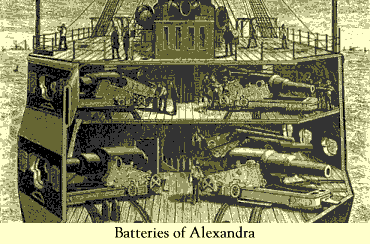 diversity in their construction. In some cases the forward and after
iron bulkheads are curved to form bow and quarter ports, in which
guns are mounted and protected even when the broadside battery is
unprotected. In other cases, where the broadside battery is protected,
and the side-armor is connected with the athwartship bulkheads forward and
shaft the battery, a port is cut in the bulkheads near the corners, and the
forward and after guns on each side are made “shifting guns,” to fire out
of either port at will. In other cases, an additional iron casemate is
constructed above the main battery. In other cases, the fire ahead and
astern is delivered from stationary turrets placed at the bow and stern,
the guns being uncovered, mounted in barbette. By these means an all-around
fire is obtained from broadside ships without interfering with the use of
the whole battery on the broadside.
diversity in their construction. In some cases the forward and after
iron bulkheads are curved to form bow and quarter ports, in which
guns are mounted and protected even when the broadside battery is
unprotected. In other cases, where the broadside battery is protected,
and the side-armor is connected with the athwartship bulkheads forward and
shaft the battery, a port is cut in the bulkheads near the corners, and the
forward and after guns on each side are made “shifting guns,” to fire out
of either port at will. In other cases, an additional iron casemate is
constructed above the main battery. In other cases, the fire ahead and
astern is delivered from stationary turrets placed at the bow and stern,
the guns being uncovered, mounted in barbette. By these means an all-around
fire is obtained from broadside ships without interfering with the use of
the whole battery on the broadside.
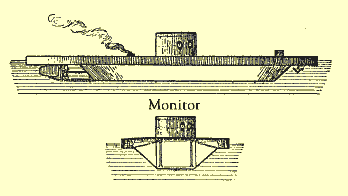 to roll that might be induced by the action of the waves. The whole
structure was like a raft on the water, and this was the original
design as conceived by the inventor. It was a most perfect gunnery
platform. The guns that were mounted on this vessel had to be
inclosed, and the most convenient form of inclosure was circular; this
was arranged so as to give lateral training to the guns by revolving, and
thus we have the origin of the system of revolving turrets for ironclad
vessels.
to roll that might be induced by the action of the waves. The whole
structure was like a raft on the water, and this was the original
design as conceived by the inventor. It was a most perfect gunnery
platform. The guns that were mounted on this vessel had to be
inclosed, and the most convenient form of inclosure was circular; this
was arranged so as to give lateral training to the guns by revolving, and
thus we have the origin of the system of revolving turrets for ironclad
vessels.
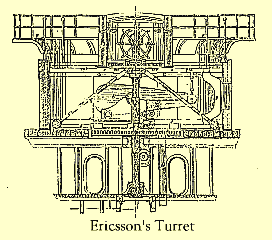 of the Monitor. In fact, it is a misnomer to style all
turreted vessels monitors, for they are only such in the one
point of common resemblance, that the battery is enclosed in a
turret. With the heavy guns now in use a turret is necessary for the
manipulation of them, but in the Monitor the turret was
adopted as a convenience, for the guns that were mounted in the
Monitor (11-inch Dahlgrens) could be worked by manpower.
The turret was not the only principle involved in the Monitor:
the low freeboard was quite as essential a feature; thus the foreign
turreted vessels, with their high freeboards and breastworks and curved
bottoms, inducing and favoring the rolling motion, do not embody the idea of
the Monitor.
of the Monitor. In fact, it is a misnomer to style all
turreted vessels monitors, for they are only such in the one
point of common resemblance, that the battery is enclosed in a
turret. With the heavy guns now in use a turret is necessary for the
manipulation of them, but in the Monitor the turret was
adopted as a convenience, for the guns that were mounted in the
Monitor (11-inch Dahlgrens) could be worked by manpower.
The turret was not the only principle involved in the Monitor:
the low freeboard was quite as essential a feature; thus the foreign
turreted vessels, with their high freeboards and breastworks and curved
bottoms, inducing and favoring the rolling motion, do not embody the idea of
the Monitor.
